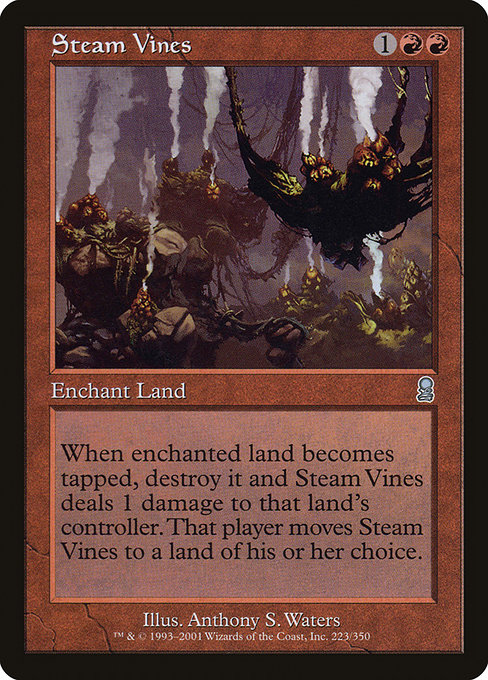
Image courtesy of Scryfall.com
Rarity vs Usability: Steam Vines in MTG Decks
If you’ve ever hunted for a spicy wrinkle to a red deck, Steam Vines has a certain nostalgic charm baked into its 2001 Odyssey origins. This uncommon aura-costed enchantment sits at a curious crossroads of rarity and utility. It’s not a common sight in modern MTG archetypes, yet it embodies a clever design philosophy: a three-mana red enchantment that pressures both land-ramp and life totals in a way only red could intend. For players who love the thrill of tempo, risk assessment, and a dash of political mischief in EDH, Steam Vines is a conversation starter even when it’s not the main course 🧙♂️🔥💎. Odyssey-era red never quite settled for straightforward burn alone; it liked a bit of strategic tug-of-war to keep opponents honest. Steam Vines fits that mold with its “Enchant land” baseline and a punishing tap-trigger. The card’s rarity is an honest reflection of its power: uncommon prints were often designed to be potent but not overbearing in the limited-game environment of the time. Today, in formats that embrace the card’s vintage identity—Legacy, Vintage, and Commander—the aura can still surprise and shape the flow of a game, especially in mosaic boards where land-ramp and land destruction collide in a spicy dance ⚔️🎨.Enchant land. When enchanted land becomes tapped, destroy it and this Aura deals 1 damage to that land's controller. That player attaches this Aura to a land of their choice.This exact wording carries its own flavor. Steam Vines invites you to think in terms of board state rather than pure permutation: a land-buttoning mechanic that punishes tapping, plus a transfer mechanic that keeps the aura from staying stagnant. The enchantment’s roots are classic red—immediate impact, risk, and a willingness to disrupt—yet the upkeep of attaching to a new land after each trigger invites shifting politics and ephemeral board control. That dynamic makes Steam Vines unexpectedly strong in certain personality-driven playgroups, even if its raw power doesn’t read as a bomb in fast modern formats. From a deck-building lens, the mana cost of {1}{R}{R} places Steam Vines squarely in the midrange of a red curve. It’s not a first-turn play, but you don’t need to be in a hurry to cast it; you want a moment where punishing an opponent’s land drop or poorly-timed tap pays dividends over the next few turns. The enchantment is also inherently fragile: a well-timed removal spell can neuter it before its first trigger, or your own tapped lands might become collateral damage if you’re not careful about sequencing. It’s a card that rewards planful play, careful timing, and a little bit of opponent psychology—the kind of craft red players relish in casual or semi-competitive tables 🧙♂️⚔️. When you weigh rarity against usability, Steam Vines demonstrates a recurring MTG truth: an uncommon card can feel decisive in the right shell, especially when it enables recurring value without needing dedicated mana sources. Its ability to “destroy the land” on tap can disrupt enemy mana bases in predictable ways, yet the subsequent reattachment to another land ensures the aura stays active across turns rather than becoming a one-shot stall tactic. In formats like Legacy and Commander, where lengthy games and land-based strategies reclaim importance, Steam Vines becomes a tool of tempo and disruption rather than a simple burn spell. It’s a reminder that rarity alone doesn’t determine impact—the synergy with the surrounding shell and the table’s temperament does 🧙♂️🔥. From a collector’s perspective, Steam Vines is a neat piece. In Odyssey’s catalog, an uncommon with a fairly specific function can appreciate in value for players chasing nostalgia or specific thematic builds. The card’s current prices reflect a niche appeal: a modest monetary footprint in nonfoil and a larger—but still approachable—one in foil. If you’re assembling a red-themed Odyssey block homage, Steam Vines can be a fun centerpiece or a quirky surprise in a budget-friendly EDH deck. The charm isn’t just nostalgia; it’s the design space Steam Vines occupies—an aggressive, hand-crafted response to the old land-versus-land dynamic that older sets cherished 💎. The card’s lore-friendly aura aligns with a broader storytelling trend in MTG: red’s romance with risk, rapid momentum, and unpredictability. Steam Vines embodies swinging between control and chaos, a motif you’ll spot echoed in other red enchantments that punish missteps while rewarding players who embrace tempo and pressure. And if you’re chasing value, remember: the art, the rarity, and the nostalgia all contribute to a little collector’s pride—the kind that makes a build sing even when the game tilts against you 🧙♂️. If this discussion nudges you toward a tactile, tactilely satisfying lifestyle beyond the table, you might check out a tool that keeps your game-space as sharp as your plays. A non-slip gaming mouse pad with a polyester surface—solid, grippy, and designed for long sessions—helps you maintain focus as you puzzle through land interactions and combat damage. You can learn more about a sturdy option here, and it might be the perfect companion while you test Steam Vines in a kitchen-table duel or a high-stakes EDH session. Non-slip Gaming Mouse Pad with Polyester Surface
More from our network
- https://blog.digital-vault.xyz/blog/post/designing-microinteractions-for-everyday-user-delight/
- https://blog.digital-vault.xyz/blog/post/stampeding-scurryfoot-redefines-mtg-metagame-trends/
- https://crypto-acolytes.xyz/blog/post/ori-blind-forest-vs-the-will-of-the-wisps-showdown/
- https://crypto-acolytes.xyz/blog/post/is-bitcoin-mining-wasteful-unpacking-energy-use-and-innovation/
- https://blog.digital-vault.xyz/blog/post/abrade-in-modern-vs-legacy-demand-explained/